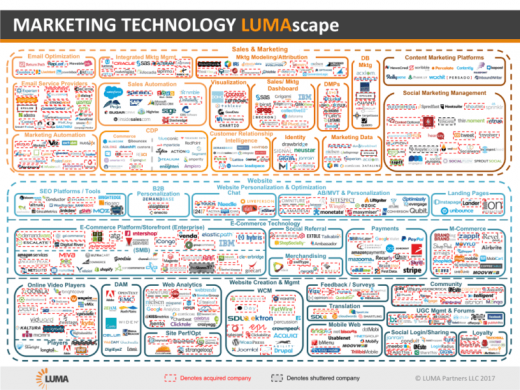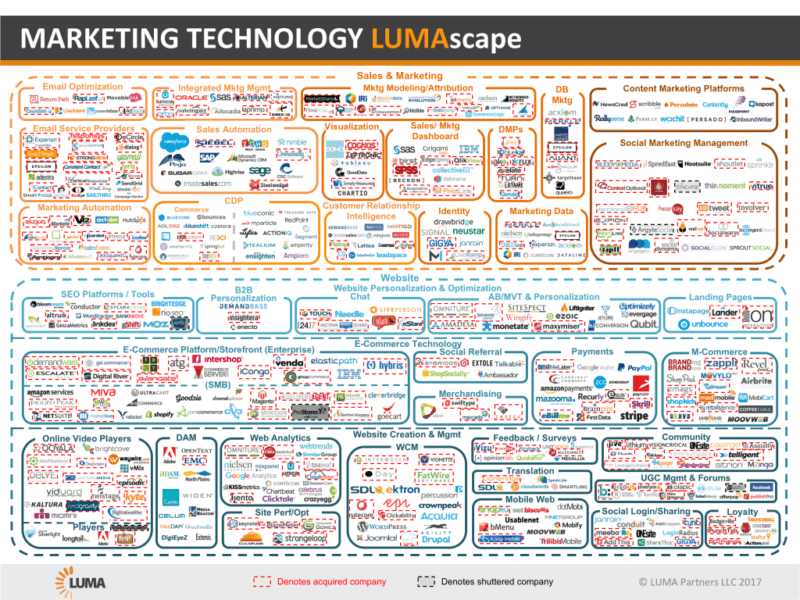Identity is having its moment, but most martech isn’t ready
With many in the industry recognizing identity as its own separate martech category, contributor Mike Sands says brands must get up to speed with this central concept.

Have you noticed anything different about the LUMAscape lately? Recently, the imposing cluster of logos representing the marketing technology landscape grew a little denser. Nestled under the data management platform (DMP) category, and to the right of the increasingly hyped customer data platform (CDP) grouping, lies a new class of martech: identity.
And it’s about time.
There is literally no piece of marketing technology that hasn’t had to address the question of customer identity in some way, shape or form. Yet for years, identity has been relegated to the background, a feature of some other platform. As a result, brands have been left with multiple siloed versions of identity within their marketing stack — a state of affairs completely counterintuitive to marketing’s ultimate goal.
So why now? Because the dominance of Amazon, the anxiety of the forthcoming General Data Protection Regulation (GDPR) and the mounting scrutiny of Facebook’s data privacy practices have made it increasingly clear that competing in today’s data-driven marketplace requires direct customer relationships. Which makes identity more than a nice-to-have: it’s an absolute imperative.
Identity, in its most basic sense, is the connection point between all customer engagements, online and off, past and present. For true identity resolution to occur, a technology solution must not only be able to match and distribute data in real time, freely and directly to any endpoint but also persist and evolve this data throughout the lifetime of the customer relationship.
And this is where most martech solutions fall short.
DMPs: The great disconnect
Take the Data Management Platform (DMP) category. For the most part, these technologies treat identity as an afterthought instead of the key to delivering customer-centric experiences. They are designed to target scaled audiences of anonymous data, not tie back customer data to existing systems for identity.
With scale — not accuracy — the driving force behind DMPs’ matching methodologies, customer identities are tied to temporary cookies, not persistent identifiers. And because DMPs rely on secondary onboarding vendors, which process customer data files in batches (a method that typically takes days), marketers are left with static, degraded, cookie-based segments that don’t provide a single, up-to-date view of customers.
Equally troublesome, DMPs are extremely limited in what they can share back with internal brand systems for analytics and segmentation. This means marketers are only able to understand a customer up to a certain point.
When customer connections are broken or missing, marketers can’t possibly engage customers with personal and contextual relevancy at strategic stages in the customer life cycle, ultimately sacrificing retention and the high lifetime values that come with maintaining long-lasting relationships.
CDPs: Glimpses of a single customer view
Also consider the rapidly emerging (yet not-so-clearly-defined) Customer Data Platform (CDP) category. According to the Customer Data Platform Institute’s 2018 Industry Update, the number of CDPs doubled in the past year alone, but only around a quarter are purpose-built; the rest either enhanced their offerings or repositioned their technology to fit the CDP mold.
While CDPs may appear to be a viable solution to identity, these platforms are only able to sync identities within a brand’s internal systems. To address customers outside of owned channels and in paid media, CDPs must rely on alliances with onboarders or walled gardens.
Lacking the scale, insights and portability of a complete and addressable identity asset, CDPs can’t create holistic customer views, leaving marketers with mere glimpses of identity.
Identity: The foundation for all customer engagement
Within the LUMAscape’s new identity category now exists a continuum of solutions specifically built to play a role in identity resolution. From highly scalable cross-device graph technologies to precisely accurate login management solutions to offline data aggregators, a variety of point solutions each fill in a specific piece of the identity puzzle, by person or by device, online or off.
Then there’s the ultimate level of identity: addressability. This subgroup houses technologies that tie together person-based digital identifiers and offline attributes into addressable data assets for cross-channel media activation.
On the low end of the addressability spectrum sit onboarding solutions, which allow a brand to “rent” its identity graphs per campaign. The resulting identity asset provides a snapshot of device linkages over the last 120 days and can be activated in paid channels for the duration of the campaign — once the campaign ends, a brand must start the process over to reach a customer again.
However, the odds that a customer is still using the same browser or cookie days later are low, making it nearly impossible for brands to capture and process real-time customer interaction data necessary to create contextually relevant brand experiences.
At the high end of addressability are identity solutions designed to allow brands to resolve identity themselves, equipping marketers with an integrated data asset they own and control. With onboarding native to the solution, an identity platform extends beyond this core capability to continuously collect and sync livestreaming identifiers with a brand’s historical first-party data, creating a persistent identity asset that enrichens throughout customer lifetimes.
Empowered with always-on identity, brands can recognize and engage individuals with in-the-moment relevancy at any touch point, leverage up-to-the-minute insights and perform closed-loop analytics.
As identity’s place on the LUMAscape attests, identity is no longer an academic conversation. It’s not an industry buzzword. It’s something brands are actually starting to solve. And as the underlying link between otherwise completely random events and customer interactions, it’s categorically critical for creating the type of 1:1 engagements brands need to succeed.
Opinions expressed in this article are those of the guest author and not necessarily Marketing Land. Staff authors are listed here.
Marketing Land – Internet Marketing News, Strategies & Tips
(59)




